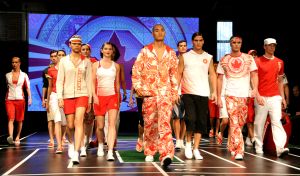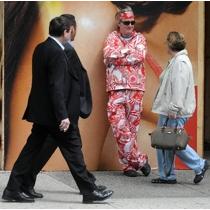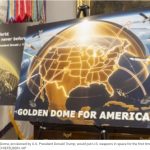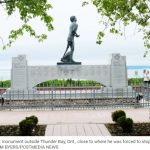制衣业挣扎经营却受冷落
加通社渥太华电/加拿大奥运选手的大部分制服都是中国货,以致若干国会议员认为不当。
新民主党国会议员杜华(Paul Dewar)周五说:“这是我们的奥运队。我们必须确保我们全部的奥林匹克运动员引以为荣地穿着加拿大生产的纺织品,以及全部的制服均必须在加拿大制造。”
自由党国会议员葛达理(Denis Coderre)表示,加拿大错失了在世界舞台宣传本国纺织业的黄金机会。
他表示,尤其不幸的是,本国制衣业正在挣扎经营的期间受到这一不可以接受的冷落。
魁北克人政团国会议员帕凯(Pierre Paquette)认为,这种冷落的做法反映出保守党政府的放任态度,不利于促进主要以魁北克为根据地的纺织业。
不过,业余运动事务部长郭姬丝(Helena Guergis)的发言人周五表示,对于使用外国生产的衣服的决定,政府也同样生气,但无力加以改变。
发言人麦克林(Blair MacLean)指出,加拿大奥委会是独立的组织,在运作方面不受政府的影响。

■加拿大海湾公司在展示一系列以枫叶旗的红白色设计的加国奥运代表队服装。 李川济摄
坚持土制 不切实际
周五较早时,加拿大奥委会行政总裁拉奇(Chris Rudge)表示,政府未有向该委员会提及这方面的问题。他又表示,政府应会了解到坚持制服完全由本土制造将会不切实际。
他续称,在有可能的情况下,该委员会会试图使用加拿大的供应商。不过,他表示,日益难以在国内找到能够生产奥运选手制服及向公众出售的仿制制服的供应商。
他说,今非昔比。
本国的制造业备受尤其是来自中国的廉价入口货及强势加元的打击。
环保新服 布料难找
负责为加拿大奥运选手设计服装的赫逊氏湾公司(Hudson’S Bay Company)开发以竹及有机棉等物料制造的环保新服装,目的是协助运动员应付北京的酷热及潮湿。
该公司女发言人玛素(Hillary Marshall)表示,这些特别的布料目前只有在亚洲较容易找到,当中尤以中国为然。
她表示,加拿大选手的服装80%都是中国货,不过,在开幕礼及上台领奖时,本国运动员所穿的制服将会全部都是在加拿大制造。
运动员作赛时所穿的运动衣并非由该公司负责。拉奇解释,这些制服属于高科技,通常全球只有一或两处地方生产。
目前要更改这些制服为时已晚。不过,国会议员杜华表示,政府必须确保2010年温哥华冬季奥运会时全部以本国制造的服装示人。
http://www.singtao.ca/tor/2008-05-03/1209804991d1001198.html
加奥运选手服装中国制 引发批评
中央社记者张若霆多伦多二日专电/参加今年北京奥运的加拿大选手服装大部份都是中国制造,令加拿大反对党议员十分不快,纷纷提出指责。
新民主党国会议员戴瓦尔表示,加拿大奥运选手穿的服装应该完全是加拿大制,如今竟大部份是中国制,完全不用大脑。
自由党国会议员柯德尔表示,加拿大奥运选手不穿本国制的服装,完全失去了在奥运会上展示加拿大纺织业成品的黄金机会。他更痛心的指出,在加拿大纺织业挣扎图存的此刻,奥运选手服装还委请外国制作,实在是对加拿大纺织业一大打击。
加拿大纺织工业主要集中在魁北克省,因此魁北克政团国会议员对此事的反应更为激烈。国会议员派吉特表示,由此一现象来看,联邦政府根本对魁北克省的福祉毫不关心。
加拿大奥林匹克委员会执行长鲁基表示,政府对于奥运选手服装应在那里制作一事并未表示意见。他感觉,联邦政府似乎并不在意。
鲁基解释,加拿大奥林匹克委员会也希望奥运选手服装能在加拿大制作,但现在国内很难找到能制作如此大量服装的厂商。因为除了制作奥运选手的服装外,制造商还须生产大量的同款商品,销售给民众。
加拿大制造业近年来受到来自中国的进口货,以及加币升值等因素,遭受惨重打击。许多纺织厂纷纷结束营业,或搬迁国外。
专为加拿大奥运选手设计服装的赫德逊海湾公司,为了帮助选手适应亚洲地区的高温,设计了一种以竹子,可可及有机棉花制成的运动服装,然而这种特殊纤维只有亚洲,特别是中国才有。
赫德逊海湾公司发言人马谢尔表示,虽然今年加拿大奥运选手百分之八十的服装都是中国制,但选手们在开幕式及领奖台上穿的服装都是加拿大制。
至于加拿大选手在竞赛中所穿的服装,据鲁基说,由于技术性很高,全世界只有一、两个地方才有能力制作,故这部份的服装也无法在加拿大制作。
戴瓦尔建议,二零一零年冬季奥运会在温哥华举行时,政府一定要确保加拿大运动员所穿的服装都是加拿大制。
赫德逊海湾公司目前已开始着手为加拿大选手设计二零一零年冬季奥运会服装。马谢尔表示,只要国内纺织业有能力,该公司十分愿意将所有服装都委请国内厂商制作。
鲁基也表示,只要一切条件许可,加拿大奥林匹克委员会也愿意将选手服装全部委请国内厂商制作。
京奥加队运动服 80%中国制造
放任外判失推广制衣业良机 渥京捱轰
2008年5月3日【明报渥太华专讯】加拿大运动员参加京奥,他们的运动服80%在中国制造,反对党国会议员周五炮轰保守党政府,责怪它采取放任态度,任由厂商外判奥运运动服,未能把握机会,推广加拿大纺织业。
自由党国会议员科德尔(Denis Coderre)藉以抨击执政保守党实施的“放任商业政策”和“惋惜失去大好机会,去向全世界显示加拿大制造业的能力。”
他续表示“不能接受”加拿大国家队的制服在中国制造,因为全世界将会有数以亿计的人观看奥运会。“这是一个极为难得的宣传机会。”
魁人政团国会议员帕克特(Pierre Paquette)指摘保守党政府对以满地可地区为中心,雇有员工4.5万多人的魁省纺织成衣制造业“毫不关心”。
他说,加拿大政府与有关单位向中国订造国家队制服的决定“是错误的”。
新民主党众议员杜华(Paul Denar)认为加拿大国家队的制服应该全部本土制造。加拿大纳税人的金钱应用来支持加拿大的纺织成衣制造业。杜华说,现在改变北京奥运会服装为时已晚,但政府应该保证2010年温哥华冬奥会采用土产运动服。
“加拿大奥委员与联邦政府必须双双对此负责,因为联邦政府在这方面,起码可以订下一定的条件。我们支持奥运健儿;必须同时支持我们的制衣业。”
自由党的科德尔和新民主党杜华在答记者问时,均婉转地避免把这项争议与中国的人权、奴工和西藏等敏感问题连在一起评论。
本届奥运会的加拿大运动员服装官方供应商是哈德逊海湾公司(Hudson’s Bay Company),它开发新的生态服装,配合北京的炎热和潮湿气候,采用竹子、有机棉等物料缝制运动服。
公司发言人马歇尔(Hillary Marshall)说,这些特别纤维只在亚洲有稳定供应,主要在中国。
马歇尔指出,尽管运动员服饰80%在中国制造,但开幕式和领奖服装全部在加拿大制造。
http://www.mingpaotor.com/htm/News/20080503/tda1.htm
Made-in-China athletes’ gear draws flak
BILL CURRY
From Saturday’s Globe and Mail
May 3, 2008 at 2:15 AM EDT
OTTAWA — Hudson’s Bay Co. is offering to boost the Canadian content of its Vancouver 2010 Olympics gear after critics raised a stink over its largely made-in-China line for Team Canada in Beijing.
MPs from the opposition Liberal Party, Bloc Québécois and NDP were all shaking their heads yesterday after learning that the federal government did not ensure greater Canadian content in the contract, especially given the financial challenges facing Canada’s textiles industry.
Instead, the uniforms from Hudson’s Bay Co. will be 80-per-cent made in China, which is hosting this summer’s Games and coming under increasing scrutiny over its human-rights record and pollution. The Olympic wear sold in retail stores like the Bay and Zellers will be 90-per-cent made in China.
The Conservative government added its voice, saying it would have preferred to see the Canadian Olympic Committee ensure the clothes be made in Canada.
“We regret the decision to produce Olympic clothes offshore,” said Blair MacLean, a spokesman for Helena Guergis, the secretary of state for sport.
This is the second of four Olympic games in which Hudson’s Bay Co. will be Canada’s official clothier, after a $100-million bid in 2005 knocked off the previous supplier, Roots, which made a point of manufacturing its Olympic clothes in Canada.
“This is a no-brainer. This is our Olympic team,” NDP MP Paul Dewar said. “We should be ensuring that all of our Olympic athletes are proudly wearing Canadian-made textiles and all of their uniforms should be made in Canada.”
Mr. Dewar expressed hope the government and Hudson’s Bay Co. will ensure the uniforms are made in Canada for the 2010 Winter Olympics in Vancouver.
“Wouldn’t that be an embarrassment to have our uniforms made in China or anywhere else for the upcoming Vancouver Olympics? So hopefully someone is doing their homework on that,” he said.
Premier Gordon Campbell, leaving a noonhour speech in North Vancouver, was approached by a TV reporter dressed in one of the uniforms.
“Let the athletes decide. If they like it, great. Good on them.”
He was asked if he would wear it. “I am not planning to wear it on a regular basis,” he deadpanned.
Hillary Marshall, the director of corporate communications for Hudson’s Bay Co., said the company turned to the Asian market, which has expertise in the organic, moisture-reducing fabrics needed for the athletes. She noted that the uniforms that will be worn by the athletes during the parade and on the podium will be 100-per-cent Canadian-made and all clothing is also 100-per-cent designed in Canada.
“We always prefer to buy Canadian,” she said, adding that most of the clothing industry has moved overseas. “We’d be very happy to sit down with the textile and garment manufacturers in this country now — because we’re starting to plan for Vancouver now — and discuss how they can provide made-in-Canada product that meets costs, the enormous quantities and the technical requirements.”
Elliot Lifson, the president of the Canadian Apparel Federation, said it would not be difficult to find Canadian suppliers for the contract.
“The argument of not finding somebody [in Canada], I don’t buy,” he said. “The argument … ‘I make it where it is the least costly,’ I buy that. I’m in business.”
While it would have been a positive symbol for the athletes’ clothing to be made in Canada, he said Hudson’s Bay Co. should not be singled out.
“If you’re going to do that, do that to everybody. … Go try and find a made-in-Canada label in Wal-Mart.”
With a report from Ian Bailey in Vancouver
Comments (533)
http://www.theglobeandmail.com/servlet/story/RTGAM.20080502.wuniforms0502/BNStory/GlobeSportsOther/
Outcry over made-in-China duds for Canadian Olympic team
Canada’s Olympians to wear clothing from China
Fri May 2, 7:18 PM
By Joan Bryden, The Canadian Press
OTTAWA – This summer’s Olympic Games isn’t the only thing made in China.
So are most of the uniforms of Canada’s Olympic athletes – and that has some MPs crying foul. “This is a no-brainer,” New Democrat MP Paul Dewar said Friday.
“This is our Olympic team. We should be ensuring that all of our Olympic athletes are proudly wearing Canadian-made textiles and all of their uniforms should be made in Canada.”
Liberal MP Denis Coderre said Canada is missing a golden opportunity to promote its textile industry on the world stage. He said it’s particularly unfortunate that the “unacceptable” snub to Canada’s homegrown clothing-makers should occur at a time when the industry is struggling.
Bloc Quebecois MP Pierre Paquette said the snub reflects the “laissez faire” attitude of the Conservative government, which he asserted is not interested in boosting the prospects of the primarily Quebec-based textile industry.
However, a spokesman for Helena Guergis, secretary of state for amateur sport, said late Friday that the government is equally annoyed with the decision to use foreign-made clothing, but is powerless to change it.
“The Canadian Olympic Committee is an independent body that operates at arm’s length from the government,” said Blair MacLean, Guergis’ communications director.
“We do not agree with the decision to produce Olympic clothing offshore and would have preferred that the clothing was made in Canada.”
Earlier Friday, Chris Rudge, CEO of the Canadian Olympic Committee, said the government had not raised the issue with the committee. He said the government likely appreciates that it would be impractical to insist on strictly Canadian-made uniforms.
Where possible, Rudge said the COC tries to use Canadian suppliers. But he said it’s becoming increasingly difficult to find Canadian manufacturers who can supply the volume of clothing required to dress the athletes and provide the “replicas” sold to the public.
“Times have changed considerably,” Rudge said.
“The reality is that there’s no longer manufacturing capacity in Canada that can meet the volume needs that are necessary to manufacture particularly the replica clothing that is sold to the public.”
Canada’s manufacturing industry has been decimated by cheap foreign imports – especially from China – and the rising Canadian dollar.
The Hudson’s Bay Company, official outfitter for Canadian Olympic athletes, has developed a new line of eco-friendly clothing intended to help athletes cope with the excessive heat and humidity in Beijing. It is made from bamboo, cocona and organic cotton.
HBC spokeswoman Hillary Marshall said such specialty fabrics are only readily available in Asia, primarily China.
While 80 per cent of the costumes provided to the athletes are made in China, Marshall said the uniforms they’ll wear during the opening ceremonies and on the medal podiums have all been made in Canada.
HBC does not supply the uniforms that athletes wear during competition, most of which Rudge said are highly technical and are often produced in only one or two places in the world.
While it’s too late to change the uniforms for the Beijing Games, Dewar said the government should ensure that only Canadian-made duds are on display during the Vancouver Winter Games in 2010.
“Wouldn’t that be an embarrassment to have, you know, our uniforms made in China or anywhere else for the upcoming Vancouver Olympics? So hopefully someone is doing their homework on that.”
HBC has already started work designing the clothing for Vancouver. Marshall said the company “would be very happy” to sit down with Canadian textile and garment manufacturers to explore their ability to provide the volume of clothing needed at competitive prices.
“As a Canadian company, we prefer to buy Canadian”
But she added: “The reality is that most of the industry has gone overseas.”
Rudge said it’s premature to talk about the uniforms for the Vancouver Games. But he said the COC “would certainly hope that we would source Canadian where it made sense, where it was economically appropriate and where it was appropriate for the environment in which we find ourselves.”
http://ca.news.yahoo.com/s/capress/oly_made_in_china
Olympic clothes turn heads on Robson
By Damian Inwood, Vancouver Province
Published: Friday, May 02, 2008
For one surreal moment, walking across Robson Street, I felt like an extra in a Jackie Chan flick.
After all, how often does anyone get a chance to make a fashion statement that bellows, “look at me!”
Heads swivelled round, fingers pointed, people snickered behind their hands.

CREDIT: Staff Photographer – The Province
Province reporter Damian Inwood hangs out downtown in his new Olympic threads on Thursday.
This was a chance to put some of the new Canadian Olympic team outfits to a Province taste test, a trial by fire.
And, not surprisingly, everyone had an opinion on the gear that went on sale at The Bay yesterday.
Some loved it, others hated it. No one was undecided.
“It’s really ugly,” said Debby Andrews, a Nanaimo retiree. “Let’s face it, if you were an athlete, would you not be devastated having to walk round like this?”
It all started in downtown Vancouver at The Bay, where Tu Ly, HBC’s Olympic designer, was holding a fashion show of the new designs.
“The tapestry print is really our hero item,” gushed Ly. “We felt we needed to create new sport camouflage that would represent the perfect fusion of China and Canada.”
The hoodie and cargo pants each cost $65, with a T-shirt at $30 and a tube/bandanna headpiece for $15.
The actual uniforms the athletes will wear in the opening and medal ceremonies will be unveiled at the 2008 Games.
After a quick change in the fitting room, it was out onto the street.
“That could be my grandma’s curtains,” chuckled sales promotions rep Jordanna Neufeld, 27, of Vancouver. “I don’t think the girls will like it. You’re going to have a hard time hooking up.”
But on Robson, the city’s fashion strip, the red-and-white colour riot met with approval.
“I like it,” said Mohameed Altamimi, 25, from Dubai, who’s taking a fire-and-safety course at Douglas College. “It’s good for Valentine’s Day. I think it would be popular at any time.”
Deb Notman wasn’t so sure.
“It looks like your pajamas,” she said. “It’s pretty busy.
Usually, women like men in uniforms, but I don’t think this one cuts it.”
Her daughter Samantha, a 19-year-old art student, was more definite.
“I think it’s a little over the top,” she said.
Plumber Kevin Dykstra, 31, was also in the “no” camp.
“Athletes thumbs down, bedtime thumbs up,” chuckled Dykstra.
Then it was down to English Bay to test the waters on the seawall.
“I think it’s dynamite – first class,” said C.J. Craig. “It certainly caught my eye. When I saw someone taking photos, I thought you were doing some modelling or were a movie star.”
Craig was sitting on a bench carving little eagles out of Brazilian soapstone, which he sometimes sells for between $40 and $50.
I pointed out that my outfit, with tax, would cost four eagles.
Vancouver actress Jesslyn Unwin, 23, thought the outfit more suited to the boudoir than the ball park.
“I don’t like it for a professional uniform, but for bedtime, sure,” said Unwin. “Coming out of the shower? Why not?”
Her friend Misha Kleider said it looked very Asian.
“It doesn’t look Canadian,” he said.
Back at the office some said I looked like I should be making sashimi in a downtown sushi house.
Others said the stylized maple leaves looked more like those found on B.C. bud. What had they been smoking?
Me? I liked it. It reminded me of a sofa that graced the conservatory at my auntie’s house in Devon, England.
And, after all, if I wear it on the plane to Beijing this summer, they might give me an upgrade.
http://www.canada.com/theprovince/news/story.html?id=06eac3d3-bfff-4f38-8504-273821b85365&k=84086



